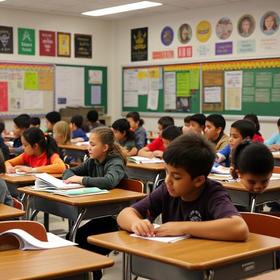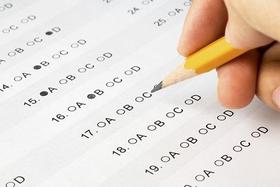For the 2025-26 school year, there are 6 public preschools serving 684 students in Lake Region Union Elementary Middle School District. This district's average pre testing ranking is 4/10, which is in the bottom 50% of public pre schools in Vermont.
Public Preschools in Lake Region Union Elementary Middle School District have an average math proficiency score of 32% (versus the Vermont public pre school average of 40%), and reading proficiency score of 36% (versus the 44% statewide average).
Minority enrollment is 8% of the student body (majority Hispanic), which is less than the Vermont public preschool average of 12% (majority Hispanic and Black).
Overview
This School District
This State (VT)
# Schools
6 Schools
206 Schools
# Students
684 Students
46,059 Students
# Teachers
58 Teachers
3,913 Teachers
Student-Teacher Ratio
12:1
12:1
Student By Grade
District Rank
Lake Region Union Elementary Middle School District, which is ranked within the bottom 50% of all 102 school districts in Vermont (based off of combined math and reading proficiency testing data) for the 2022-2023 school year.
Overall District Rank
#65 out of 103 school districts
(Bottom 50%)
(Bottom 50%)
Math Test Scores (% Proficient)
32%
40%
Reading/Language Arts Test Scores (% Proficient)
36%
44%
Science Test Scores (% Proficient)
31%
35%
Students by Ethnicity:
Diversity Score
0.15
0.22
% American Indian
n/a
n/a
% Asian
n/a
2%
% Hispanic
4%
4%
% Black
1%
2%
% White
92%
88%
% Hawaiian
n/a
n/a
% Two or more races
3%
4%
All Ethnic Groups
District Revenue and Spending
The revenue/student of $19,047 in this school district is less than the state median of $29,860. The school district revenue/student has stayed relatively flat over four school years.
The school district's spending/student of $20,858 is less than the state median of $29,121. The school district spending/student has stayed relatively flat over four school years.
Total Revenue
$13 MM
$2,348 MM
Spending
$14 MM
$2,290 MM
Revenue / Student
$19,047
$29,860
Spending / Student
$20,858
$29,121
Best Lake Region Union Elementary Middle School District Public Preschools (2025-26)
School
(Math and Reading Proficiency)
(Math and Reading Proficiency)
Location
Quick Facts
Rank: #11.
Glover Community School
(Math: 45-49% | Reading: 55-59%)
Rank:
Rank:
8/
Top 30%10
100 School Street
Glover, VT 05839
(802) 525-6958
Glover, VT 05839
(802) 525-6958
Gr: PK-8 | 91 students Student-teacher ratio: 10:1 Minority enrollment: 4%
Rank: #22.
Brownington Central School
(Math: 35-39% | Reading: 40-44%)
Rank:
Rank:
5/
Bottom 50%10
103 Chase Road
Orleans, VT 05860
(802) 754-8467
Orleans, VT 05860
(802) 754-8467
Gr: PK-8 | 111 students Student-teacher ratio: 14:1 Minority enrollment: 5%
Rank: #33.
Orleans Elementary School
(Math: 35-39% | Reading: 35-39%)
Rank:
Rank:
5/
Bottom 50%10
53 School Street
Orleans, VT 05860
(802) 754-6650
Orleans, VT 05860
(802) 754-6650
Gr: PK-8 | 106 students Student-teacher ratio: 12:1 Minority enrollment: 12%
Rank: #44.
Irasburg Village School
(Math: 11-19% | Reading: 35-39%)
Rank:
Rank:
2/
Bottom 50%10
292 Route 58 East
Irasburg, VT 05845
(802) 754-8810
Irasburg, VT 05845
(802) 754-8810
Gr: PK-8 | 69 students Student-teacher ratio: 8:1 Minority enrollment: 4%
Rank: #55.
Barton Graded School
(Math: 25-29% | Reading: 25-29%)
Rank:
Rank:
2/
Bottom 50%10
137 Church Street
Barton, VT 05822
(802) 525-3636
Barton, VT 05822
(802) 525-3636
Gr: PK-8 | 135 students Student-teacher ratio: 10:1 Minority enrollment: 11%
Rank: #66.
Albany Community School
(Math: 11-19% | Reading: 11-19%)
Rank:
Rank:
1/
Bottom 50%10
351 Main Street
Albany, VT 05820
(802) 755-6168
Albany, VT 05820
(802) 755-6168
Gr: PK-8 | 172 students Student-teacher ratio: 17:1 Minority enrollment: 8%
Recent Articles

How Public Schools Support Students on Free / Reduced-Lunch Programs
Explore how U.S. public schools support students eligible for free or reduced-price lunch through nutrition, academic, and wraparound services in 2025.

Hidden Costs of Public Schools: Fees, Supplies & Extras
Explore the hidden costs in public schools—fees, supplies, extracurriculars—and how parents can plan for them in 2025.

Public School Funding 2025: What Families Should Know
Essential insights on public school funding in 2025—how it works, what’s changing, and what families should know to stay ahead.





